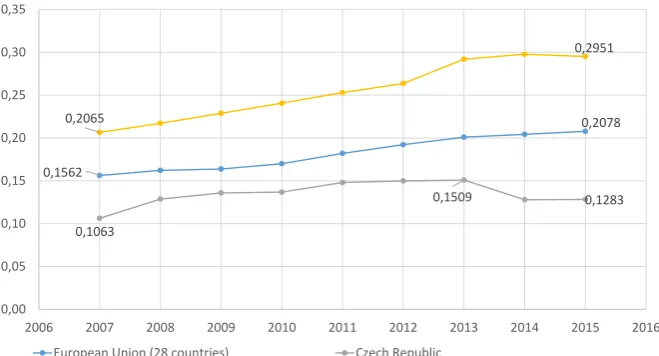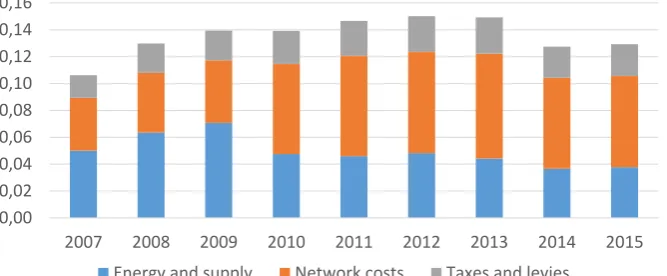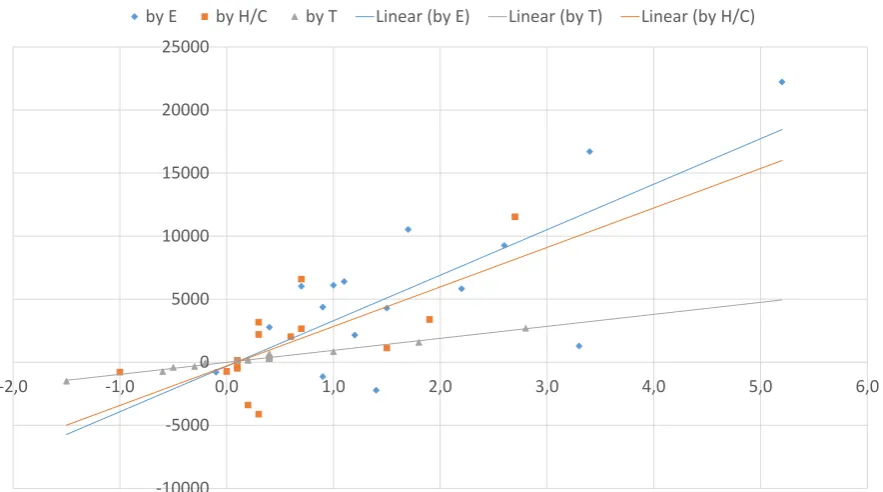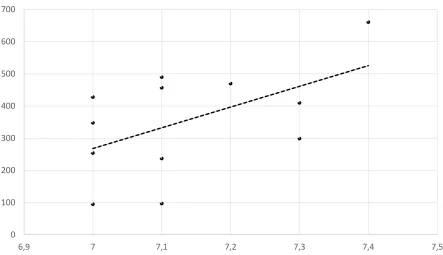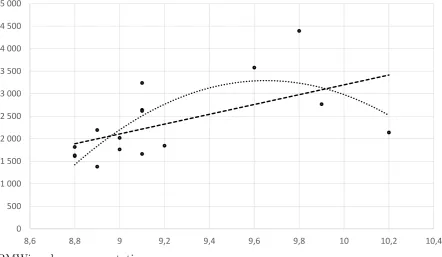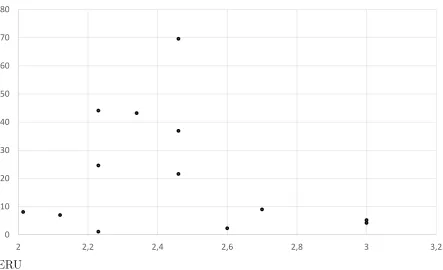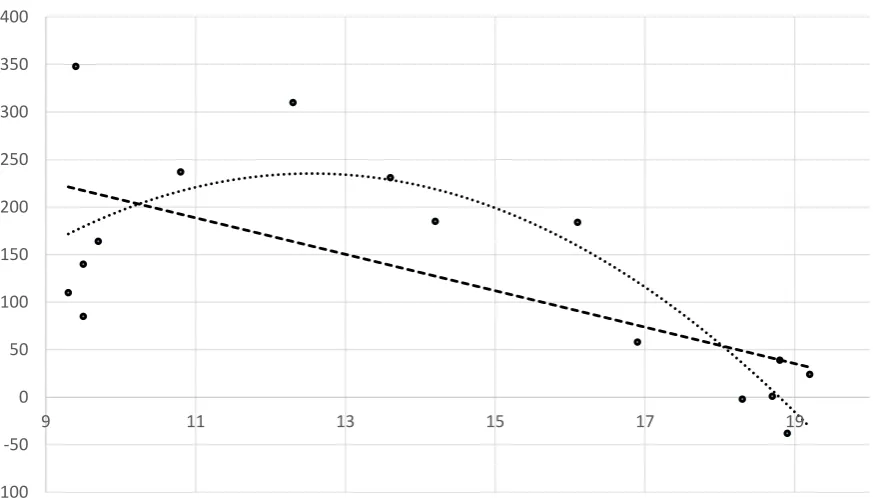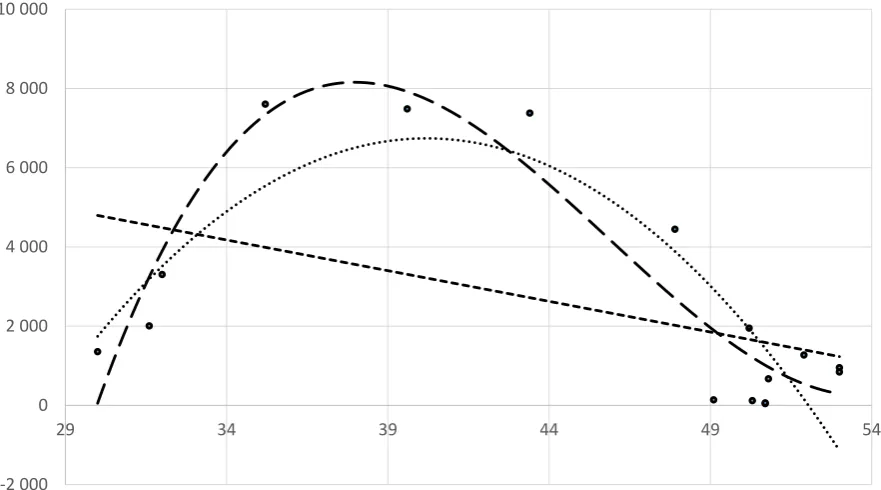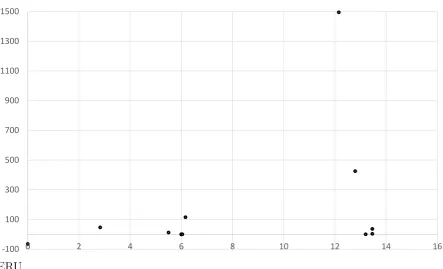Munich Personal RePEc Archive
Empirical evidence on renewable
electricity, greenhouse gas emissions and
feed-in tariffs in Czech Republic and
Germany
Janda, Karel and Tyuleubekov, Sabyrzhan
5 December 2016
Online at
https://mpra.ub.uni-muenchen.de/75444/
Empirical evidence on renewable electricity,
greenhouse gas emissions and feed-in tariffs in Czech
Republic and Germany
∗
Karel Janda
a,band Sabyrzhan Tyuleubekov
aa
Charles University in Prague
b
University of Economics, Prague
December 5, 2016
Abstract
In this paper we estimated relation between greenhouse gas abatement and share of renewable energy resources in Germany and Czech Republic. We also analysed the dependence between annual installed capacities of RES and respective feed-in tariffs. We took the empirical data of annual installed capacities and regressed it on respective feed-in tariffs (FIT) and/or their polynomials. The analysis resulted in optimum intervals for some types of RES, which are summarised in our paper. We could not collect most of the data for the Czech Republic, since the Energy Regulatory Office of the Czech Republic does not publish the time series for RES, unlike Germany, which publishes a comprehensive database regarding RES. Opti-mum intervals in our paper indicate at which values of FIT the biggest amount of installed capacities is anticipated. Thus, if FIT scheme to be continued after 2017, FITs should be set inside these intervals. These intervals assume that there are not any caps and restrictions.
Keywords: Renewable energy, feed-in tariff, Czech renewables, German Renewables
JEL Codes: G32, L94, L51, O44, Q28.
∗Email addresses: Karel-Janda@seznam.cz (Karel Janda), styuleubekov@gmail.com (Sabyrzhan
1
Introduction
This paper provides a simple econometric analysis of renewable energy resources (RES)
and their connection with greenhouse gas (GHG) emission and feed-in tariffs. We run
the regressions of GHG abatement by the means of RES-E, RES-H/C and RES-T on
RES-E, RES-H/C and RES-T share in final gross consumption respectively. In addition,
we estimate GHG abatement for 2020. We also analyse how FITs and installed capacities
of RES are correlated. Therefore, we will try to find the optimum intervals of FITs for
each type of RES by analysis of empirical data. We are not analysing actual generation
of energy by RES, since it is dependent on weather conditions and etc. i.e. factors which
are hardly can be controlled. Likewise, we are not analysing the results of auctions
al-ready held in Germany, since there is no enough data in order to draw some conclusions,
nonetheless some summary about this scheme is provided. Thereby, the optimum
inter-vals we found can be used until 2017, unless European Commission will not postpone
the removal of FIT support mechanisms. Moreover, FITs inside the optimal intervals do
not minimise overall costs of supporting RES, they are indicating FITs values at which
installed capacities of RES can be maximised.
2
Renewables and greenhouse gas emissions
2.1
Renewables supporting policies
German Renewable Energy Sources Act (EEG) is widely considered as a very successful
tool for increasing share of RES in electricity consumption. Nonetheless, this has come
with excessive costs for end customers. German household electricity prices went up from
14 EURcent/kWh in 2000 to 29 EURcent/kWh in 2013, see Figure 1 for more details
about the development of prices for households.
Among RES technologies, only large hydropower stations are not dependent on
Figure 1: Prices for households
0,1562
0,2078
0,1063
0,1509 0,1283
0,2065
0,2951
0,00 0,05 0,10 0,15 0,20 0,25 0,30 0,35
2006 2007 2008 2009 2010 2011 2012 2013 2014 2015 2016
European Union (28 countries) Czech Republic
Germany (until 1990 former territory of the FRG)
Eurostat
technology. End customers through so-called EEG levy pay all additional costs associated
with subsidies. In 2000, EEG levy was 0.19 EURcent/kWh and increased to the level of
6.24 EURcent/kWh in 2014. See Figure 2 for more details about the price structure of
German households. The overall cost of EEG subsidies increased drastically during 2009
– 2014, from about EUR 5 billion in 2009 to some EUR 25 billion in 2014. (Poser et al.,
2014).
Price structure for Czech households is different. As it can be seen from Figure 3,
taxes and levies account for moreless same portion since 2008. In fact, it slightly increased
from 2.21 EURcent/kWh in 2009 to 2.36 EURcent/kWh in 2015, growth of only 6.8%.
Whereas in Germany for the period from 2009 to 20141 growth was 64%. However, the
surcharge for support of RES went up from 6.7 EUR/MWh in 2010 to 19.8 EUR/MWh
in 20142. The development of price structure of Czech households is depicted in Figure 3.
From 2001 until 2008, amount of feed-in tariffs in Germany went up from some EUR
1.6 billion to EUR 9 billion. With such large amounts of subsidies, only 211.1 million euros
1
Figure 2: German price structure
0,00 0,05 0,10 0,15 0,20 0,25 0,30 0,35
2007 2008 2009 2010 2011 2012 2013 2014
Energy and supply Network costs Taxes and levies
Eurostat
Figure 3: Czech price structure
0,00 0,02 0,04 0,06 0,08 0,10 0,12 0,14 0,16
2007 2008 2009 2010 2011 2012 2013 2014 2015
Energy and supply Network costs Taxes and levies
Eurostat
were allocated to R&D in renewable energies by government, this accounts for 3% of the
[image:5.595.132.466.448.586.2]have been very successful in aspect of increasing installed capacities of RES. In Germany,
photovoltaics, the recipient of highest FITs, increased its capacity from 100 MW in 2000
to 5311 MW in 2008. In the Czech Republic, installed capacity of PV between 2008 and
2010 soared from 39.5 MW to 1959.1 MW. In addition, Prusa et al. (2013) calculated
that in 2011 average usage of Czech PV plants was only 1099 hours (12.54% of the total
number of hours in the year) and the total cost of PV subsidies was about EUR 972
million and EUR 216 million out of this amount is ”the pure dead weight loss”. Prusa
et al. (2013) define the pure DWL as follows: The pure DWL component is a net loss
to the economy, because it captures the extent of inefficient electricity production. p02 .
The pure DWL is equivalent to an artificial cost which would not exist were it not for the
subsidies. This cost appears because money is invested in PV production capacity that
is more expensive than other feasible sources.
Feed-in tariffs are usually granted for 20 years, this is a good feature for investors,
since they can be assured in long-term support. So even if they would be abolished this
year, additional costs will still be paid for 19 years by end customers, if no retrospective
legislation will be put in force. While, putting retrospective laws in force is a very bad
signal for investors, since they cannot be confident with safety of their investments. In
2010, Czech Republic introduced retroactive legislation in the form of a withholding tax
of 26% for photovoltaics with installed capacity of over 30 kW valid for 2011 – 2013.
Furthermore, Czech government cancelled previously guaranteed tax-free period of first
five years of a project life. The impact was instantaneous, annual installed capacities
of PV plummeted from 1494.5 MW in 2010 to 11.9 MW in 2011, 99.2% decrease in
just one year. Average annual installed capacities for the period 2011 – 2014 is 27.075
MW, furthermore, in 2014 there was even negative installed capacity, i.e. dismantling
of some3 PV stations. Moreover, such legislative action of the Czech government also
indirectly impacted wind sector, in 2011 only 1.1 MW of wind capacity were installed,
whereas in 2010 24.6 MW of wind capacity were installed, 95.5% decrease in just one year.
3
Hydropower also was affected, in 2011 1.5 MW of hydropower capacity were dismantled,
while in 2010 19.6 MW of hydropower capacity were installed, i.e. more than 100%
decrease. Of course we cannot claim, that PV, wind and hydropower sectors declines
were caused solely by the Czech legislative action. For instance, additional reason for
PV sector decline is a stoppage of connections into the grid for new PV plants in 2010,
this problem is more explained in section 3.1.1. Nevertheless, we see that a large drop
in installed capacities occurred next year after Czech government introduced such an
unpopular legislation.
In Germany, FITs for wind farms put in operation in 2003 are expected to be lower
than prices for electricity in 2022 (Frondel et al., 2009). Therefore, it will take 19 years
for wind farms to be competitive without subsidies. It should be mentioned that onshore
wind is considered as moreless mature technology.
Furthermore, technology specific feed-in tariffs reduce competition within RES. If
FITs would have been same for all types of RES, we would not be able to claim that
PV installations would had resulted in same capacities as now. Though in Germany,
installations of PV plant capacities exceed that ones of biomass, biomass has generated
much more energy than solar PV plants. So if subsidies would be the same, it probably
would be more economically reasonable to invest into biomass sector rather than into PV
sector. Prusa et al. (2013) found out that in the Czech Republic, for PV plants to be
non-loss making either prices have to go up seven times or costs have to be reduced seven
times.
Whilst prices for end customers increased, wholesale prices have decreased. In
Ger-many, base load prices plummeted from 90-95 EUR/MWh in 2008 to 37 EUR/MWh in
2013. This created financial problems for utilities that operated thermal power plants.
German utilities companies stocks went down by almost 45 percent from 2010 to 2014
and credit ratings are lowered for them from A to A- or in case of RWE even to BBB+
(Poser et al., 2014).
R&D. Now producers of RES-E are induced to be more cost efficient via degressive rates
of FITs.
Likewise, Menanteau et al. (2003) suggest introduction of ”optimum environmental
tax”. So consumers would be induced to choose between efficient use of energy from
conventional resources or use energy from RES without such tax. So if the cost of
pollution and other environmental damage from conventional production of energy can
be properly estimated such Pigovian tax can be introduced. This would correct the
market imperfections (Menanteau et al., 2003). We know similar tax as tax on CO2
emissions.
2.2
Problems of integrating renewable energy into the grid
One more problem of renewables is grid connection. Producers of RES-E are entitled to
have a priority access into the grid. But locations of some plants are far away from the
grid, for instance offshore wind farms in Germany. So expansion of transmission grids
needs large investments. Investment costs for Germany are estimated to be approximately
EUR 40 billion (Poser et al., 2014) over the decade. There is the ”Grid Development
Plan” in Germany, which encompasses development of infrastructure and connection of
north offshore wind plants with southern regions. In 2012, energy transition induced four
German TSOs to spend EUR 1.15 billion4 on network infrastructure.
In the Czech Republic, the most favourable locations for wind farms are along the
German and Polish borders, as well as Slovakian border and also in the Moravian
high-lands. Accordingly, they are remote from the biggest consumption centers such as Prague,
Ostrava and Brno. Until 2023, Czech TSO is going to invest into expansion of the grid
CZK 60-70 billion5 (EUR 2.2 - 2.59 billion; exchange rate is 27) this is the biggest
in-vestment in the history6 of the country. However, this expansion is planned not only
due to increasing installed capacities of RES but mainly because of increasing capacity
4
https://ec.europa.eu/energy/en/content/2014countryreportsgermany
5
of nuclear power. In contrast with Germany, Czech Republic is not planning to abandon
nuclear power.
In the Czech Republic, in February 2010 due to technical reasons Czech TSO requested
stoppage of connections into the grid for new PV plants. Czech TSO stated that excessive
amount of new PV plants can threaten security of the grid.
For grid operators there are also so-called grid balancing costs. Such costs arise due to
intermittent character of some types of RES. Wind and solar technologies are dependent
on weather, so when there is no wind wind farms do not generate electricity and when
there is a cloudy sky PV plants do not generate electricity. Thus, grid operators must
balance out electricity capacities in the grid in order to prevent stoppages of electricity
supply and security of the grid. Next section discusses intermittency problem more
detailed.
2.3
Intermittent character of renewable energy
Many proponents of RES say that RES will decrease dependency from depleting fossil
fuels. However, RES tend to have intermittent character. For example, onshore wind
farm with installed capacity of 100 MW will produce only 20-35%7 of electricity that it
would have produced if suitable weather conditions were holding all the year round –
this is known as the capacity factor. For solar PV plants, the capacity factor is between
10-20%8.In order to save customers from blackouts backup energy systems must be in
place. In Germany, on January 5, 2012 solar and wind combined production was 500
GWh, maximum for that year; and minimum was on December 19, 2012 with combined
production of only 30 GWh. Therefore, large backup capacities of thermal power plants
must be in place (Poser et al., 2014).
There are different ways to tackle the problem of intermittency, the major ones are:
• Use of fossil fuels, so at times when RES-E producers are unable to meet the
de-7
FS-UNEP, 2016
8
mand, conventional plants start to produce electricity. Maintenance of such systems
is costly. For Germany, amount of EUR 590 million in 2006 was calculated by
Erd-mann (2008). The use of fossil fuels is relatively easy and cheap only in case of
long-term balancing (i.e. days or week notice).
• Transmission of surplus from one location to another, this requires good
intercon-nection between locations. This goes back to the development of the grid and also
may require good collaboration between the states. In addition, it will increase the
grid balancing costs.
• Demand response, so when RES expected to produce low volume of electricity, large
industrial and commercial customers are paid by the grid operator to lower their
consumption of electricity by switching off machines and/or air conditioning etc.
The amount of payment must be properly calculated, nevertheless this method is
costly and difficult to implement. This method is relatively easy to implement in
medium-term notice (i.e. hours).
• Energy storage, surplus of produced RES-E is stored and when RES-E producer
cannot meet the demand stored electricity is fed into the grid. Probably the best
option in short notice (i.e. seconds to minutes).
The latter option is promising because prices for batteries have been falling. For
example, prices of electric vehicle batteries are steadily decreasing. The average cost
per kWh fell from some 1000 $ in 2010 (EUR 757.57, exchange rate is 1.32, which is
average monthly rate for 2010) to some 390 $9 in 2015 (EUR 354.55, exchange rate is
1.10, which is average monthly rate for 2010). The decrease is caused by technological
improvements as well as economies of scale. This is also driven by increasing demand for
electric vehicles. There are two types of storage: so-called ”behind the meter” and the
grid-scale storage.
9
Behind the meter storages are located inside the buildings and reserved for self use.
Germany has a subsidy programme for small-scale PV installations with storage effective
from 2013. By the end of September 2015, 27 000 storage systems were sold with capacity
of 136 MWh10.
Grid-scale battery storages are of much larger capacities and located close to wind
farms or solar plants. For instance, in Germany 5 MWh storage system was put in
operation for utility which operates a large share of wind energy. In 2015, worldwide
1220 MW11 of grid-scale projects were announced.
Nonetheless, the storage systems increase the costs of RES-E. In 2015, German
lev-elised cost of electricity for onshore wind farm with storage of 50% of total installed
capacity is 120 $/MWh12 (EUR 109.09, exchange rate is 1.10), which is 48% higher than
without storage capacity. For PV plants such cost is 198 $/MWh13 (EUR 180, exchange
rate is 1.10), which is 85% higher than without storage. Consequently, we see that storage
systems increase the costs substantially, yet these costs tend to decrease, since prices for
batteries decrease and overall development of storage technology is promising.
In addition, wholesale prices have become dependent on weather conditions.
Whole-sale prices go down when the sun shines and the wind is strong and go up when no wind
and no sun but high demand for power remains. Therefore, price forecasts for futures
have become more subtle and complicated.
2.4
Reduced CO2 emissions
Prices of CO2 emission certificates, which are traded on European Emissions Trading
System (ETS), have never been above 30 EUR/tonne of CO2. In 2008, calculated cost
of abatement one tonne of CO2 emission by PV in Germany was 716 euros and by wind
energy was 54 euros (Frondel et al., 2009). Therefore, from economic point of view it is
10
See prev. note
11
See prev. note
12
See prev. note
13
much more beneficial to buy certificates than subsidize renewable energies.
Nevertheless, in 2009, about 340 million metric tonnes of CO2 emissions were saved
by the use of RES in EU. Taking the price of 15 EUR/tonne of CO2 in 2009, savings will
result in EUR 51 billion for 2009 year alone (Poser et al., 2014).
In order to see correlation between change in RES share in gross final energy
con-sumption and greenhouse gas (hereinafter GHG) abatement for Germany we will run the
following regressions14
GHGE = β0 +β1RESE
GHGHC = β0 +β1RESHC
GHGT = β0 +β1REST
where, GHGE = GHGEt−GHGEt−1, i.e. yearly change in amount of GHG
abate-ment induced by change in RES-E share in gross final electricity consumption; and
RESE = RESEt −RESEt−1, i.e. yearly change of RES-E share in gross final
elec-tricity consumption. Analogously, other two regressions should be read. Likewise, all
three regressions were tested for heteroskedasticity (hettest), normality (swilk) and
spec-ification test for omitted variables (ovtest) results can be found in Appendix A in notes
under the relevant table.
No regressions were run for the Czech Republic due to lack of data.
Figure 4 is a scatter plot for all three regressions. Y-axis is measured in tonnes of CO2
equivalent and X-axis is measured in percentage points. Regression of GHG abatement
by RES-E resulted in R-squared of 0.5653, i.e. 56.53% of variability in dependent variable
is explained by the independent one. Likewise, equation of the regression – a blue line –
14
Figure 4: GHG abatement by different types of RES
-10000 -5000 0 5000 10000 15000 20000 25000
-2,0 -1,0 0,0 1,0 2,0 3,0 4,0 5,0 6,0
by E by H/C by T Linear (by E) Linear (by T) Linear (by H/C)
is:
\
GHGE=−317.18
(1820.415) + 3609(845..79)046RESE
Coefficient is statistically significant even at 1% significance level. Thus, one percent
increase of RES-E share in gross final electricity consumption results in abatement of
3609.046 tonnes of CO2 equivalent. Constant in this regression is statistically
insignifi-cant.
Regression of GHG abatement by RES-H/C has R-squared of 0.5113. Equation of
the regression line – an orange line – is:
\
GHGHC =−290.5662
(818.14)
+ 3132.254
(818.3969)RESHC
Constant is statistically insignificant, whereas coefficient is statistically significant even
at 1% significance level. Therefore, when RES-H/C share in final energy consumption in
CO2 equivalent.
Regression of GHG abatement by RES-T has R-squared of 0.9851, which is almost
perfect correlation. Equation of the regression line – a grey line – is:
\
GHGT =−6.637
(31.26)
+ 951.2398
(31.3) REST
Here constant is also statistically insignificant and coefficient is statistically significant
even 1% significance level. Thus, 1% increase in RES-T share energy consumption in
transport increases GHG abatement by 951.239 tonnes of CO2 equivalent.
Having these results and estimations of RES shares from Table 2.2 we can estimate
the amount of GHG abatement in 2020 by multiplication of relevant coefficients with
estimated shares of relevant RES. Thereby, we have the following estimations:
RES −E2020xcoef.RESE = 139309.2
RES −H/C2020xcoef.RESHC = 48549.94
RES −T2020xcoef.REST = 12556.37
All estimations are measured in tonnes of CO2 equivalent. Thus, we have that in
2020 year alone total estimated GHG abatement is 200 415.5 thousand tonnes of CO2
equivalent, according to German NREAP 215 million tonnes of CO2 equivalent will be
prevented by 2020, thus there is less than 7% discrepancy between my estimations and
German NREAP estimations. Taking into account that prices of certificates on ETS
should increase, savings in money equivalent will be significant. If we take current price15
of EU Emission Allowance – 6.05 EUR per tonne of CO2 equivalent, we can estimate
that savings in 2020 year alone will be 1.213 billion EUR. However, these estimation is
assuming that prices will remain at its current level, whereas they must go up, since the
15
number of the certificates will gradually go down. This estimation is conducted in order
to show you the size effect of GHG abatement.
3
Installed renewable capacity and feed-in tariffs
3.1
Model
We are going to analyse dependence between feed-in tariffs and installed capacity of each
type of RES-E in Germany and the Czech Republic via linear regression. Firstly, we will
use simple linear regression, our dependent variable will be installed capacity in year t,
M Wt, and independent variable will be FIT in year t, F ITt. Thus, the equation will be:
M Wt=β0 +β1F ITt
Then for some types of RES we will add polynomial of second order and in two cases
polynomial of third order, in case of Czech solar RES we will add a polynomial of fourth
order and a dummy, reasoning will be explained later. Therefore the equations will be:
M Wt =β0+β1F ITt2 +β2F ITt
M Wt=β0+β1F ITt3+β2F IT
2
t +β3F ITt
M Wt=β0+β1F ITt4+β2F IT
3
t +β3F IT
2
t +β4F ITt+β5D
All successful regressions (i.e. p-value of F-test is lower than 0.05 or in some cases lower
than 0.1) were tested for heteroskedasticity (hettest), normality (swilk) and specification
test for omitted variables (ovtest) results can be found in Appendix A in notes under the
relevant table.
For Germany data will be taken between years 2000 and 2015. However, if value of
F ITt for some t is zero, then this year is omitted. There are such cases in landfill, sewage
were introduced also in 2004, and in offshore wind RES, where FITs were introduced in
2009. The data for Germany is taken from Federal Ministry for Economic Affairs and
Energy. It should be mentioned that each technology-specific average FIT for a given
year will be used as F ITt.
For the Czech Republic data will be taken for 2002 – 2015 period. No restrictions on
value of F ITt are imposed. Nevertheless, for the Czech Republic we managed to collect
much less data than for Germany. We could not find data about installations of biomass
and biogas16 RES. The data for the Czech Republic is taken from the Energy Regulatory
Office.
3.2
Results of the model
Regression for German hydropower resulted in statistically insignificant coefficient of
F IT, p-value of the coefficient is 0.543. In addition, R-squared is only 0.0271, which
means that only 2.71% of variability in dependent variable is explained by the independent
one. Finally, regression itself is insignificant, since p-value of the F-test is 0.5426. This
is caused by the fact that sites for such RES technology are scarce, since can be located
only on rivers. Therefore, there is no relation between the size of FIT and installation
amounts. Average annual growth rate of installed capacity for the period of 2001 – 2015
is 0.99%. It should be noted, that hydropower is the most mature type of RES among
all, since it has been developing for decades.
Regression for Czech hydropower also resulted in statistically insignificant coefficient
of F IT, p-value of the coefficient is 0.585. R-squared of the regression is only 0.0527.
This is caused by the same reasons as in German case.
Figure 5 is a scatter plot for German landfill, sewage and mine gas RES. Y-axis is
the amount of annual installed capacity of this RES in MW. X-axis is a feed-in tariff in
16
Figure 5: German landfill, sewage and mine gas
0 100 200 300 400 500 600 700
6,9 7 7,1 7,2 7,3 7,4 7,5
BMWi and own computations
EURcent/kWh. Equation of the line is:
[
M W = −4239
(2325.79)
+ 643.87
(325.99)F IT
Thus, one cent of FIT corresponds to 643.87 MW of installed capacity. For instance, if in
year t+1 FIT will be increased by one cent, then installed capacity will be increased by
643.87 MW in comparison to year t. p-value of the coefficient is 0.07617, i.e. coefficient
is statistically significant at 10% significance level. Likewise, overall significance of the
regression is achieved only at 10% significance level, since p-value of the F-test is 0.0765.
In addition, so far maximum change of FIT was 0.2 cent, increase in 2011 from 7.2 to 7.4
and decrease in 2013 from 7.3 to 7.1. R-squared of this equation is 0.2806, i.e. independent
variable explains 28.06% of variability of dependent variable. Though, average growth
rate of FIT between 2005 and 2015 is only 0.14%, average annual growth rate of installed
capacity is 20.97%.
17
No regression was run for the Czech Republic due to lack of data.
Geothermal type of RES started to develop in Germany in 2007, when the first 2 MW
of this type of RES were installed. Average growth rate of installed capacity is 55%,
nonetheless there were years with no increase at all and years such as 2012, when 13 MW
were added, resulting in 260% increase in comparison to 2011. Regression resulted in
statistically insignificant coefficient and constant, with p-values 0.34 and 0.55 respectively.
Moreover, overall regression is insignificant, p-value of the F-test is 0.3396. This is caused
by scarcity of this type of RES, i.e. special site needed to be found in order to generate
geothermal energy. Therefore, feed-in tariffs do not impact amount of installed capacity
of this type of RES.
[image:18.595.75.518.367.624.2]No regression was run for the Czech Republic due to lack of data.
Figure 6: German onshore wind
0 500 1 000 1 500 2 000 2 500 3 000 3 500 4 000 4 500 5 000
8,6 8,8 9 9,2 9,4 9,6 9,8 10 10,2 10,4
BMWi and own computations
Figure 6 is a scatter plot for German onshore wind RES. Y-axis and X-axis are same
as in Figure 5. Equation of the dashed line is
Therefore, one cent of FIT corresponds to 1090 MW of installed capacity. For instance,
if in year t+1 FIT will be increased by one cent, then installed capacity in year t+1
will be increased by 1090 MW in comparison to year t. R-squared of this equation is
0.3208, i.e. independent variable explains 32.08% of variability of dependent variable.
p-value of independent variable is 0.022, i.e. it is statistically significant at 5%
signif-icance level, whereas, p-value of constant is 0.069, i.e. it is not statistically significant
at 5% significance level, however at 10% significance level it is statistically significant.
But, Breusch-Pagan test for heteroskedasticity yields that there is a constant variance18.
Nevertheless, when we add in the model a polynomial of the second order, Breusch-Pagan
test for heteroskedasticity rejects null hypothesis, which is constant variance of dependent
variable fitted values. Likewise, R-squared increases to the level of 0.5525, all coefficients
and constant are statistically significant at 5% significance level. The equation of this
model – dotted line – is:
[
M W =−2570.459
(991.01) F IT
2+ 49620.89 (18714.03)F IT
−236183.6
(88148.72)
By calculating the maximum of this parabola we find the optimum FIT for onshore
wind RES, i.e. under this FIT the maximum annual installed capacity is anticipated.
The optimum FIT is 9.65 EURcent/kWh. Therefore, higher FITs are inefficient, since
they result in lower installed capacities at higher expenses. Likewise, FITs below 8.52 will
result in negative installed capacities. Therefore, FITs should be set inside (8.52;9.65]
interval. In addition, average growth rate of FIT is only 0.40% for the period of 2001 –
2015, average installed capacity growth rate is 14.16%.
Figure 7 is a scatterplot for Czech wind RES. Y-axis is in MW of installed capacity and
X-axis is a feed-in tariff in CZK/kWh. I have run various regressions: simple ones, with
polynomials of the second, third and even fourth orders. No regression was successful. It
is seen from Figure 7 that data is very dispersed, thus very difficult to draw a line which
18
Figure 7: Czech wind
0 10 20 30 40 50 60 70 80
2 2,2 2,4 2,6 2,8 3 3,2
ERU
would approximately match the pattern. In all regressions, overall p-values were greater
than 0.1706. Thus, we can conclude that wind installations are independent from FITs.
Figure 8: German offshore wind
-500 0 500 1 000 1 500 2 000 2 500
14,5 15 15,5 16 16,5 17 17,5 18 18,5 19
[image:20.595.75.518.464.708.2]Figure 8 is a scatter plot for offshore wind RES in Germany. Y-axis and X-axis are
same as in Figure 5. Equation of the dashed line is
[
M W =−6702.93
(2616.775)
+ 438.46
(159.46)F ITt
Hence, one cent of FIT corresponds to 438.46 MW of installed capacity. For instance, if
in year t+1 FIT will be increased by one cent, then installed capacity will be increased by
438.46 MW in comparison to year t. R-squared of this equation is 0.6019, i.e. independent
variable explains 60.19% of variability of dependent variable. Independent variable is
statistically significant at 5% significance level, p-value of constant is 0.051, i.e. constant
is almost statistically significant at 5% significance level. Yet, Ramsey RESET test
concludes that we have omitted variables19. Accordingly, when we add in the model a
polynomial of second order, R-squared of the model increases to the level of 0.9910, i.e.
model explains 99.1% of variability in the dependent variable. In addition, all coefficients
and constant are statistically significant even at 1% significance level. The equation of
the model – dotted line – is:
[
M W = 353.0522
(26.86775)F IT
2−11207.84
(886.7051)F IT + 88725(7275.592).89
The minimum corresponds to the point where derivative changes its sign, i.e. negative
marginal returns change to increasing marginal returns. The minimum here is 15.8727,
parabola at this point is below zero, i.e. when FIT is set at 15.8727 annual installed
capacity will be negative. So producers of RES will dismantle their wind farms. Actually,
parabola is negative when values of FIT are inside [15.0764;16.6691] interval. Therefore,
FITs should not be set inside this interval. However, such model implies that FIT set at
0 will result in 88725.89 MW of installed capacity, which is barely can make sense. In
order to exclude this shortcoming of the model, we add a polynomial of third order, and
19
now the model – wide dashed line – is:
[
M W = 9
(24.15052)9.41284F IT
3−4656.334 (1216.998)F IT
2+ 72632.58 (20371.35)F IT
− 377268
(113251.5)
All coefficients and constant are statistically significant at 5% significance level.
R-squared increased a little bit to the level of 0.9986. There are two points where derivative
is zero: 15.1436 and 16.082. Inside the interval of these two values marginal returns
are negative. Therefore it is inefficient to set FITs inside this interval. In addition,
FITs set below 14.5612 result in negative installed capacities. Accordingly, FITs should
be set inside the intervals (14.5612;15.1436] and (16.5519; +∞). We excluded interval
(16.082;16.5519) because FITs set inside [14.6736;15.1436] interval result in same installed
capacities but with lower FITs.
First offshore wind farms in Germany were installed in 2009, with 30 MW. Ever since,
the average annual growth rate of installed capacity is 126%. Offshore wind projects are
very expensive, since they have excessive initial investment costs. And the project makes
sense only if it is of bigger scale, that is why we see such big growth rates of installed
capacities. This type of RES showed incredible growth, with only 30 MW installed in
2009, 3283 MW were installed in 2015 alone. Growth of more than 10 000 % in 6 years.
Figure 9 is a scatter plot for biomass RES. Y-axis and X-axis are same as in Figure 5.
Equation of the dotted line is
[
M W = 399.44
(82.6653)
−19.16
(5.66)F ITt
That is, one cent of FIT corresponds to decrease of 19.16 MW of installed capacity.
For instance, if in year t+1 FIT will be increased by one cent, then installed capacity
will be decreased by 19.16 MW in comparison to year t. Constant and independent
variables are statistically significant at 5% significance level. R-squared of this equation
Figure 9: German biomass
-100 -50 0 50 100 150 200 250 300 350 400
9 11 13 15 17 19
BMWi and own computations
0.6808. Coefficients remain statistically significant at 5% significance level, but p-value of
constant is 0.075, thus constant is statistically significant only at 10% significance level.
The equation of the model – dotted line – is:
[
M W =−6.027
(1.966) F IT
2+ 151.2494 (55.77982)F IT
−713.6272
(368.9966)
The maximum of the parabola is the optimum FIT, i.e. maximum annual installed
capacity is achieved under this FIT. The maximum is at 12.5476, consequently FITs
higher than 12.5476 are inefficient, since they will result in lower installed capacities
at higher costs. In addition, FITs set below 6.29957 will result in negative installed
capacities. Therefore, FITs should be set inside (6.29957;12.5476] interval. Average
growth rate of FIT between 2001 and 2015 is 5% and average annual growth rate of
installed capacity is 16%. Nevertheless, in recent years the growth slowed down to average
of 0.62%20. The boom of installations of this type of RES was between 2001 and 2006
20
with average annual growth rate of 33%.
[image:24.595.77.518.152.397.2]No regression was run for the Czech Republic due to lack of data.
Figure 10: German solar energy
-2 000 0 2 000 4 000 6 000 8 000 10 000
29 34 39 44 49 54
BMWi and own computations
Figure 10 is a scatter plot for solar RES in Germany. Y-axis and X-axis are same as
in Figure 5. Equation of the line is
[
M W = 9441.76
(3542.484)
−154.9
(77.53)F IT t
Constant is statistically significant at 5% significance level and independent variable is
statistically significant only at 10% significance level as well as whole regression is
signifi-cant only at 10% significance level. R-squared of this equation is 0.2219, i.e. independent
variable explains 22.19% of variability of dependent variable. With one cent increase in
FIT, installed capacity will decrease by 154.9 MW. But, Ramsey RESET test concludes
that we have omitted variables. Thence, we add a polynomial of second order. All
co-efficients and constant become statistically significant even at 1% significance level and
level of 0.7148. The equation of the model – dotted line – is:
[
M W =−48.062F IT
(10.138)
2+ 3863.828 (849.1176)F IT
−70916.21
(17096.32)
The optimum FIT for this model is where parabola has its maximum. The maximum
is at 40.1963, consequently, FITs higher than 40.1963 are inefficient. Furthermore, FITs
set below 28.3546 result in negative installed capacities. Therefore, FITs should be set
inside (28.3546;40.1963] interval. Yet, Ramsey RESET test still concludes that we have
omitted variables. Thus, we add polynomial of third order and Ramsey RESET test does
not conclude that we have omitted variables. It slightly changes our intervals. Likewise,
R-squared increases to the level of 0.8531, all coefficients and constant remain statistically
significant at 1% significance level. The equation of the model – wide dashed line – is:
[
M W = 4.0298
(1.19885)F IT
3−554.4399 (150.8367)F IT
2+ 24675.01 (6223.685)F IT
− 350005
(84994.61)
There are two points where derivative is zero: 37.9719 and 53.7514. Inside the
inter-val of these inter-values marginal returns are negative, thus, it is inefficient to set FIT
be-tween 37.9719 and 53.7514. In addition, FITs set below 29.9764 will result in
nega-tive installed capacities. Therefore, FITs should be set inside the following intervals:
(29.9764;37.9719] and (61.6409; +∞). We excluded interval (53.7514; 61.6409), since
val-ues inside [30.0824;37.9719] result in the same installed capacities but at lower FITs.
This is the only type of RES for which average FIT has been steadily decreasing since
2006, average decrease rate of 5% between years 2006 and 2015. Nonetheless, average
annual installed capacity growth rate for the same period is 16%, with boom in 2009
with 128% annual growth rate. Moreover, now there are 3 consecutive years of negative
annual growth rates of installed capacity.
Figure 11 is a scatter plot for Czech solar energy. Y-axis and X-axis are same as
in Figure 7. As it has already been written, in 2010 Czech government introduced a
Figure 11: Czech solar energy
-100 100 300 500 700 900 1100 1300 1500
0 2 4 6 8 10 12 14 16
ERU
there was an unexpected boom of photovoltaic installations, which led to stoppage of
connections into the grid for new PV installations. That is why, I added a dummy
variable ”D”, which was equal 1 only for 2010 year and 0 for all others years. Only after
adding polynomial of fourth order regression was moreless successful. Ramsey RESET
test still concluded that there is an omitted variable, though at 4% significance level
did not. Breusch-Pagan test for heteroskedasticity did not detect any heteroskedasticity.
Regression equation is:
[
M W = −0.698
(0.1704983)F IT
4+ 16.12 (4.298)F IT
3 −107.27 (35.039)F IT
2+ 228.829
(101.4919)F IT + 913(137.984).9D
−64.49
(74.32)
Constant here is statistically insignificant. Function for FITs has three values where
derivatives are zero: 1.57; 4.72; 11.026. Inside (1.57;4.72) interval marginal returns are
negative, i.e. it is inefficient to set FITs inside this interval. Inside [4.72;11.026) marginal
returns are positive. However, FITs should be set inside the following intervals: (0;1.57]
result in same installed capacities.
Table 1: Summary of optimal FITs
Type of RES Interval for optimum FITs
German onshore wind (8.52; 9.65]
German offshore wind (14.56; 15.14] and (16.55; +∞) German biomass (6.29; 12.55]
German solar (29.98; 37.97] and (61.64; +∞) Czech solar (0; 1.57] and (6.64; 11.03]*
Note: for Czech solar intervals include shortages explained before.
Table 1 summarizes all found optimum intervals for feed-in tariffs. We did not find
optimum intervals for FITs in cases of: hydro RES of both countries, landfill,sewage and
mine gas RES of both countries, Czech wind RES and Czech biomass. Moreover, optimum
interval of FITs for Czech solar includes some shortages explained before. Therefore, we
have optimum intervals for FITs in 5 cases. Thereby, we believe that if feed-in tariff
scheme to be continued and governments want to maximize their installed capacities
of RES, they should set feed-in tariffs inside these intervals. For Germany, FITs are
measured in euros and for the Czech Republic FITs are measured in Czech korunas.
4
Conclusion
The main purpose of this paper was to determine what are the growth opportunities of
renewable energy and how renewable energy is financed in the Czech Republic and
Ger-many. After reviewing German and Czech renewables policies we conclude that support
for renewable energy is mainly covered by end-customers. End-customers of both
coun-tries have additional costs related to support of RES included in their bills. Additional
costs related to RES include: feed-in tariffs and other financial types of support, grid
development costs and grid balancing costs. All these costs are firstly borne by TSOs
and DSOs but then they are passed onto end-customers. However, not all additional
costs are borne by end-customers, in the Czech Republic, there is a subsidy, which covers
some tax benefits. This support resulted in significant increase of installed capacities in
all types of RES excluding hydro, since it has already been very developed. However,
since feed-in tariff scheme is regarded as a very costly method and moreover, European
Commission has approved the removal of all feed-in tariff schemes from 2017, Germany
has already started to shift towards auction scheme.
Various shortcomings related to renewables are discussed and some ways of how to
resolve these shortcomings are provided. We estimated relation between GHG abatement
and share of RES. We also analyse the dependence between annual installed capacities
of RES and respective feed-in tariffs. We took the empirical data of annual installed
capacities and regressed it on respective FITs and/or their polynomials. The analysis
resulted in optimum intervals for some types of RES, they are summarised in our paper.
We could not collect most of the data for the Czech Republic, since the Energy Regulatory
Office of the Czech Republic does not publish the time series for RES, unlike Germany,
which publishes a comprehensive database regarding RES.
Optimum intervals in our paper indicate at which values of FIT the biggest amount of
installed capacities is anticipated. Thus, if FIT schemes are to be continued after 2017,
FITs should be set inside these intervals. These intervals assume that there are not any
caps and restrictions. Nonetheless, there were regressions with statistially insignificant
results, for instance, hydro RES in Germany and the Czech Republic. In this case, we
conclude that size of FITs do not really plays a big role in decision making of investors,
i.e. investors are more concerned about other factors rather than about FITs. Likewise,
Bibliography
• Erdmann, G. (2008): “Indirekte Kosten der EEG-Foerderung. Kurz-Studie im
Auftrag der WirtschaftsVereinigungMetalle”Technische Universitaet Berlin
• Frondel, M., N. Ritter, C. M. Schmidt & C. Vance (2010): “Economic
im-pacts from the promotion of renewable energy technologies: The German
experi-ence.” Energy Policy 38: pp. 4048–4056.
• IRENA and CEM (2015): “Renewable Energy Auctions – A Guide to Design.”
• Jirous, F., (2011): “Integration of electricity from renewables to the electricity
grid and the electricity market – RES – Integration. National report: Czech
Re-public”eclareon
• Menanteau, P., D. Finon& M. Lamy (2003): “Prices versus quantities:
choos-ing policies for promotchoos-ing the development of renewable energy”Energy Policy 31: pp. 799–812.
• Poser, H., J. Altman, F. ab Egg, A. Granata & R. Board (2014):
“De-velopment and integration of renewable energy: lessons learned from Germany”
Finadvice
• Prusa, J., A. Klimesova & K. Janda (2013): “Consumer loss in Czech
Appendix A – Regression Outputs
Table 2: Stata output for German GHG abatement by RES-E
Source SS df MS Number of obs 16
F( 1, 14) 18.21 Model 3.54E+08 1 3.5E+08 Prob>F 0.0008 Residual 2.72E+08 14 1.9E+07 R-squared 0.5653
Adj R-squared 0.5343 Total 6.27E+08 15 4.2E+07 Root MSE 4410.9 GHGEDE Coef. Std. Err. t P>t [95% Conf. Interval] RESEshareDE 3609.046 845.7903 4.27 0.001 1795.007 5423.086 cons -317.18 1820.415 -0.17 0.864 -4221.58 3587.222
Note: ovtest Prob >F = 0.7104; hettest Prob >chi2 = 0.1165; swilk Prob >Z = 0.0911
Table 3: Stata output for German GHG abatement by RES-H/C
Source SS df MS Number of obs 16
F( 1, 14) 14.65 Model 1.08E+08 1 1.1E+08 Prob >F 0.0018 Residual 1.04E+08 14 7393880 R-squared 0.5113
Adj R-squared 0.4764 Total 2.12E+08 15 1.4E+07 Root MSE 2719.2 GHGHCDE Coef. Std. Err. t P>t [95% Conf. Interval] RESHCshareDE 3132.254 818.3969 3.83 0.002 1376.967 4887.541 cons -290.566 818.1411 -0.36 0.728 -2045.3 1464.172
[image:30.595.68.531.344.502.2]Table 4: Stata output for German GHG abatement by RES-H/C
Source SS df MS Number of obs 16
F( 1, 14) 923.55 Model 13027681 1 1.3E+07 Prob >F 0 Residual 197484.9 14 14106.1 R-squared 0.9851
Adj R-squared 0.984 Total 13225166 15 881678 Root MSE 118.77 GHGTDE Coef. Std. Err. t P>t [95% Conf. Interval] RESTshareDE 951.2398 31.30108 30.39 0 884.1057 1018.374 cons -6.63744 31.26193 -0.21 0.835 -73.6876 60.41274
[image:31.595.74.522.349.489.2]Note: ovtest Prob >F = 0.3923; hettest Prob >chi2 = 0.9475; swilk Prob >Z = 0.13027
Table 5: Stata output of German regression for hydro RES
Source SS df MS Number of obs 16
F( 1, 14) 0.39 Model 4526.865 1 4526.865 Prob>F 0.5426 Residual 162676.1 14 11619.72 R-squared 0.0271
Adj R-squared -0.0424 Total 167202.9 15 11146.86 Root MSE 107.79 MWHydroDE Coef. Std. Err. t P>t [95% Conf. Interval] FITHydroDE -18.1088 29.01279 -0.62 0.543 -80.33507 44.11741 cons 211.4045 236.0032 0.90 0.386 -294.7721 717.5811
Note: no tests were done, since regression is insignificant.
Table 6: Stata output of Czech regression for hydro RES
Source SS df MS Number of obs 8
F( 1, 6) 0.33 Model 41.81111 1 41.81111 Prob>F 0.5845 Residual 751.9777 6 125.3296 R-squared 0.0527
Adj R-squared -0.1052 Total 793.7888 7 113.3984 Root MSE 11.195 MWhydroCZ Coef. Std. Err. t P>t [95% Conf. Interval] FIThydroCZ 7.676342 13.29032 0.58 0.585 -24.84389 40.19658 cons -15.9082 38.97599 -0.41 0.697 -111.279 79.46259
[image:31.595.79.518.571.708.2]Table 7: Stata output of German regression for landfill, sewage and mine gas RES
Source SS df MS Number of obs 12
F( 1, 10) 3.9 Model 85677.72 1 85677.72 Prob >F 0.0765 Residual 219624 10 21962.4 R-squared 0.2806
Adj R-squared 0.2087 Total 305301.7 11 27754.7 Root MSE 148.2 MWlandfillDE Coef. Std. Err. t P>t [95% Conf. Interval] FITlandfil∼E 643.8705 325.9901 1.98 0.076 -82.48075 1370.222 cons -4239.11 2325.79 -1.82 0.098 -9421.292 943.0728
[image:32.595.83.515.352.489.2]Note: ovtest Prob >F = 0.6085; hettest Prob >chi2 = 0.8844; swilk Prob >Z = 0.18622
Table 8: Stata output of German regression for geothermal RES
Source SS df MS Number of obs 12
F( 1, 10) 1.01 Model 15.53274 1 15.53274 Prob>F 0.3396 Residual 154.4673 10 15.44673 R-squared 0.0914
Adj R-squared 0.0005 Total 170 11 15.45455 Root MSE 3.9302 MWgeoDE Coef. Std. Err. t P>t [95% Conf. Interval] FITgeoDE 0.282413 .2816304 1.00 0.34 -0.3450982 0.909925 cons -3.40822 5.511267 -0.62 0.55 -15.68808 8.871653
Note: no tests were done, since regression is insignificant.
Table 9: Stata output of German regression for onshore wind RES
Source SS df MS Number of obs 16
F( 1, 14) 6.61 Model 3314183 1 3314183 Prob >F 0.0222 Residual 7015292 14 501092.3 R-squared 0.3208
Adj R-squared 0.2723 Total 10329475 15 688631.7 Root MSE 707.88 MWonshoreDE Coef. Std. Err. t P>t [95% Conf. Interval] FITonshoreDE 1090.021 423.8435 2.57 0.022 180.9671 1999.075 cons -7703.76 3906.02 -1.97 0.069 -16081.33 673.8246
[image:32.595.74.523.564.718.2]Table 10: Stata output of German regression for onshore wind RES with polynomial of 2nd order
Source SS df MS Number of obs 16
F( 2, 13) 8.02 Model 5706569 2 2853284 Prob >F 0.0054 Residual 4622906 13 355608.2 R-squared 0.5525
Adj R-squared 0.4836 Total 10329475 15 688631.7 Root MSE 596.33 MWonshoreDE Coef. Std. Err. t P>t [95% Conf. Interval] FITonshoreDE 49620.89 18714.03 2.65 0.02 9191.685 90050.1 FITonshore∼q -2570.46 991.0165 -2.59 0.022 -4711.42 -429.498
cons -236184 88149.72 -2.68 0.019 -426620 -45747.7 Note: ovtest Prob >F = 0.2548; hettest Prob >chi2 = 0.0984;
[image:33.595.76.521.336.501.2]swilk Prob >Z = 0.80035
Table 11: Stata output of German regression for offshore wind RES
Source SS df MS Number of obs 7
F( 1, 5) 7.56 Model 2325630 1 2325630 Prob >F 0.0403 Residual 1538064 5 307612.9 R-squared 0.6019
Adj R-squared 0.5223 Total 3863694 6 643949 Root MSE 554.63 MWoffshoreDE Coef. Std. Err. t P>t [95% Conf. Interval] FIToffshor∼E 438.4589 159.4633 2.75 0.04 28.54531 848.3724 cons -6702.93 2616.775 -2.56 0.051 -13429.57 23.69948
Note: ovtest Prob >F = 0.0027; hettest Prob >chi2 = 0.0994; swilk Prob >Z = 0.29774
Table 12: Stata output of German regression for offshore wind RES with polynomial of 2nd order
Source SS df MS Number of obs 7
F( 2, 4) 219.9 Model 3828870 2 1914435 Prob >F 0.0001 Residual 34823.56 4 8705.889 R-squared 0.991
Adj R-squared 0.9865 Total 3863694 6 643949 Root MSE 93.305 MWoffshoreDE Coef. Std. Err. t P>t [95% Conf. Interval] FIToffshor∼E -11207.8 886.7051 -12.64 0 -13669.7 -8745.96 FIToffshor∼q 353.0522 26.86775 13.14 0 278.4554 427.649
cons 88725.89 7275.592 12.20 0 68525.61 108926.2 Note: ovtest Prob >F = 0.1291; hettest Prob >chi2 = 0.5067;
[image:33.595.74.525.559.724.2]Table 13: Stata output of German regression for offshore wind RES with polynomial of 3rd order
Source SS df MS Number of obs 7
F( 3, 3) 736.62 Model 3858456 3 1286152 Prob >F 0.0001 Residual 5238.035 3 1746.012 R-squared 0.9986
Adj R-squared 0.9973 Total 3863694 6 643949 Root MSE 41.785 MWoffshoreDE Coef. Std. Err. t P>t [95% Conf. Interval] FIToffshor∼E 72632.58 20371.35 3.57 0.038 7801.834 137463.3 FIToffshor∼q -4656.33 1216.998 -3.83 0.031 -8529.36 -783.305 FIToffshor∼u 99.41284 24.15052 4.12 0.026 22.55512 176.2706
cons -377268 113251.5 -3.33 0.045 -737685 -16851.2 Note: ovtest Prob >F = 0.5667; hettest Prob >chi2 = 0.5080;
[image:34.595.75.527.344.510.2]swilk Prob >Z = 0.65274
Table 14: Stata output of German regression for biomass RES
Source SS df MS Number of obs 16
F( 1, 14) 11.46 Model 89203.11 1 89203.11 Prob >F 0.0044 Residual 108981.9 14 7784.421 R-squared 0.4501
Adj R-squared 0.4108 Total 198185 15 13212.33 Root MSE 88.229 MWbiomassDE Coef. Std. Err. t P>t [95% Conf. Interval] FITbiomassDE -19.1608 5.660266 -3.39 0.004 -31.30086 -7.02074 cons 399.4383 82.66532 4.83 0 222.1388 576.7378
Note: ovtest Prob >F = 0.0544; hettest Prob >chi2 = 0.1122; swilk Prob >Z = 0.61289
Table 15: Stata output of German regression for biomass RES with polynomial of 2nd order
Source SS df MS Number of obs 16
F( 2, 13) 13.86 Model 134919.1 2 67459.55 Prob >F 0.0006 Residual 63265.91 13 4866.608 R-squared 0.6808
Adj R-squared 0.6317 Total 198185 15 13212.33 Root MSE 69.761 MWbiomassDE Coef. Std. Err. t P>t [95% Conf. Interval] FITbiomassDE 151.2494 55.77982 2.71 0.018 30.74439 271.7543 FITbiomass∼q -6.02677 1.966364 -3.06 0.009 -10.2748 -1.7787
[image:34.595.78.522.560.734.2]Table 16: Stata output of German regression for solar RES
Source SS df MS Number of obs 16
F( 1, 14) 3.99 Model 25337064 1 25337064 Prob >F 0.0655 Residual 88859997 14 6347143 R-squared 0.2219
Adj R-squared 0.1663 Total 1.14E+08 15 7613137 Root MSE 2519.4 MWpvDE Coef. Std. Err. t P>t [95% Conf. Interval] FITPVDE -154.907 77.53224 -2.00 0.066 -321.1972 11.38301 cons 9441.761 3542.484 2.67 0.018 1843.888 17039.63
Note: ovtest Prob >F = 0.0000; hettest Prob >chi2 = 0.0711; swilk Prob >Z = 0.05059
Table 17: Stata output of German regression for solar RES with poly-nomial of 2nd order
Source SS df MS Number of obs 16
F( 2, 13) 16.29 Model 81632652 2 40816326 Prob >F 0.0003 Residual 32564409 13 2504955 R-squared 0.7148
Adj R-squared 0.671 Total 1.14E+08 15 7613137 Root MSE 1582.7 MWpvDE Coef. Std. Err. t P>t [95% Conf. Interval] FITPVDE 3863.828 849.1176 4.55 0.001 2029.421 5698.235 FITpvDEsq -48.0617 10.13821 -4.74 0 -69.9639 -26.1594
cons -70916.2 17096.32 -4.15 0.001 -107851 -33981.9 Note: ovtest Prob >F = 0.0005; hettest Prob >chi2 = 0.5904;
[image:35.595.81.517.546.733.2]swilk Prob >Z = 0.61751
Table 18: Stata output of German regression for solar RES with poly-nomial of 3rd order
Source SS df MS Number of obs 16
F( 3, 12) 23.23 Model 97424828 3 32474943 Prob >F 0 Residual 16772233 12 1397686 R-squared 0.8531
Adj R-squared 0.8164 Total 1.14E+08 15 7613137 Root MSE 1182.2 MWpvDE Coef. Std. Err. t P>t [95% Conf. Interval] FITPVDE 24675.01 6223.685 3.96 0.002 11114.76 38235.25 FITpvDEsq -554.44 150.8367 -3.68 0.003 -883.085 -225.795 FITpvDEcu 4.029787 1.198853 3.36 0.006 1.417711 6.641863
cons -350005 84004.61 -4.17 0.001 -533035 -166974 Note: ovtest Prob >F = 0.0611; hettest Prob >chi2 = 0.8394;
Table 19: Stata output of Czech regression for solar RES with poly-nomial of 4th order
Source SS df MS Number of obs 13
F( 5, 7) 74.82 Model 2067825 5 413565.1 Prob>F 0 Residual 38692.84 7 5527.548 R-squared 0.9816
Adj R-squared 0.9685 Total 2106518 12 175543.2 Root MSE 74.347 MWpvCZ Coef. Std. Err. t P>t [95% Conf. Interval] FITpvCZqu -0.69811 .1704983 -4.09 0.005 -1.101274 -0.29495 FITpvCZcu 16.12037 4.297576 3.75 0.007 5.958221 26.28252 FITpvCZsq -107.27 35.03922 -3.06 0.018 -190.1249 -24.4157 FITpvCZ 228.8294 101.4919 2.25 0.059 -11.16089 468.8196 CZdummy 913.9999 137.9842 6.62 0 587.7191 1240.281 cons -64.4934 74.32014 -0.87 0.414 -240.2327 111.2458
